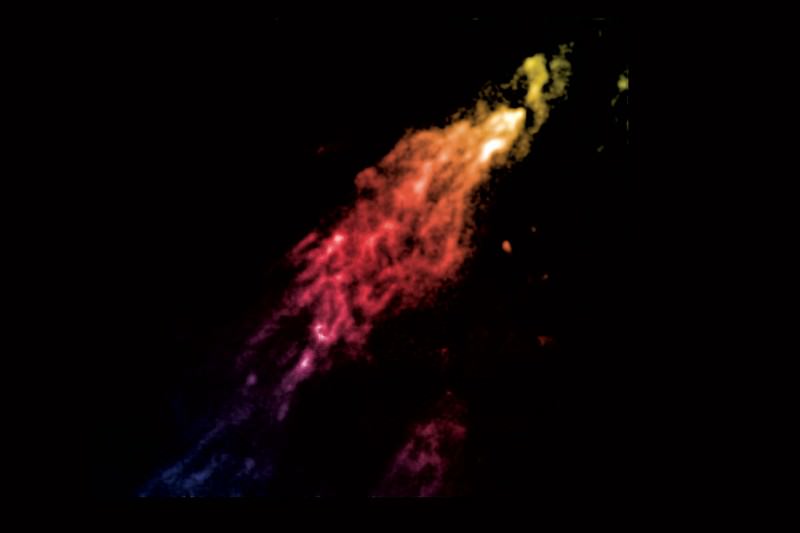







| BOOKS | F. A. Q. | ARTICLES | TALKS | ABOUT KEN | DONATE | BEYOND OUR KEN |
|---|
By Ken Croswell
Published on New Scientist (December 15, 2015)

Credit: C. Bill Saxton, NRAO/AUI/NSF.
Call it the comeback kid. A massive cloud of gas crashing into the Milky Way probably started its life in our Galaxy, according to new observations from the Hubble Space Telescope.
Located 40,000 light-years from Earth, Smith’s Cloud is 11,000 light-years long, 2500 light-years across, and has a mass millions of times that of our Sun. If we could see it, it would span 30 times the diameter of the Full Moon from tip to tail.
But because it is made mostly of hydrogen gas, it is nearly invisible. It was discovered in the early 1960s when astronomer Gail Smith detected radio waves emitted by its hydrogen atoms. In 2008, other astronomers reported that the cloud is moving towards the Milky Way and will crash into its disc in 27 million years.
“This cloud has always stood out as something of an oddball,” says Andrew Fox, an astronomer at the Space Telescope Science Institute in Baltimore, Maryland.
Some thought Smith’s Cloud was fresh gas falling into the Milky Way, or a starless galaxy carrying gas and shrouded in dark matter. Either way, the cloud should contain few elements heavier than hydrogen and helium, which are made by stars.
Now Fox and his colleagues have used Hubble to observe ultraviolet light from three active galactic nuclei that lie billions of light-years beyond Smith’s Cloud. By measuring how this light filters through the cloud, they can work out the heavy elements in its composition.
They found that sulphur atoms in the cloud absorb so much ultraviolet light that its sulphur-to-hydrogen ratio is half that of the Sun, suggesting stars have polluted it. This means the cloud is hardly a pristine relic from the dawn of time.
Instead, it is probably material cast out of the Galaxy’s disc that is now falling back in.
“I think that’s by far the best explanation,” says David Nidever, an astronomer at the University of Arizona in Tucson.
The cloud is as rich in sulphur as the Milky Way’s outer disc, and earlier calculations of its trajectory indicated that, if it did come from our Galaxy, it arose about 70 million years ago from a part of the disc 15,000 light-years farther from the Galactic centre than the Sun and Earth are.
But the new finding raises a puzzle: what could catapult such a massive cloud out of the Milky Way’s disc? Exploding stars eject material, but no supernova-driven cloud is nearly so massive.
“It certainly has left us scratching our heads,” Fox says.
After getting blasted out of the Milky Way, the cloud may have gained additional mass by accreting some of the hot tenuous gas that pervades the Galaxy’s halo. Still, Fox doubts whether this process would have added enough material to explain the cloud’s total mass.
Ken Croswell earned his Ph.D. in astronomy from Harvard University and is the author of The Alchemy of the Heavens and The Lives of Stars.
"An engaging account of the continuing discovery of our Galaxy...wonderful." --Owen Gingerich, The New York Times Book Review. See all reviews of The Alchemy of the Heavens here.
"A stellar picture of what we know or guess about those distant lights."--Kirkus. See all reviews of The Lives of Stars here.
| BOOKS | F. A. Q. | ARTICLES | TALKS | ABOUT KEN | DONATE | BEYOND OUR KEN |
|---|